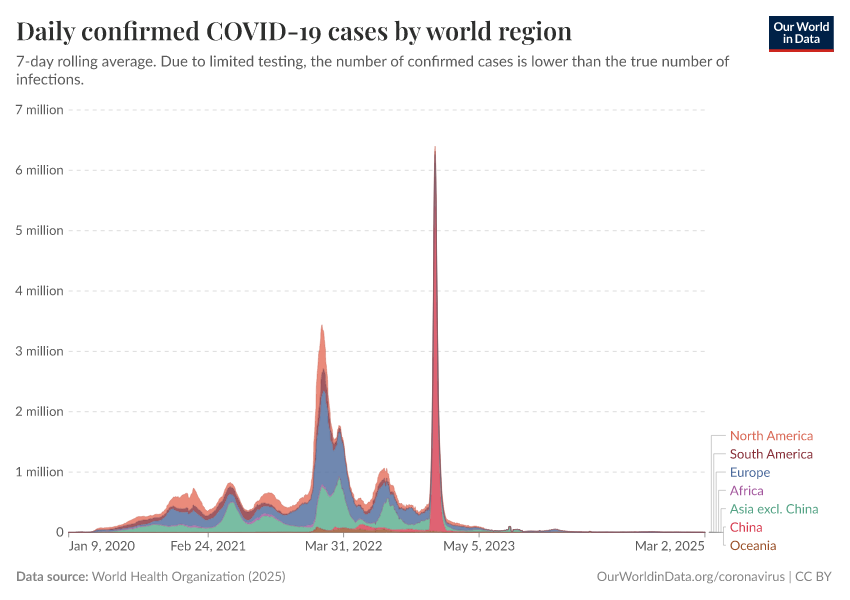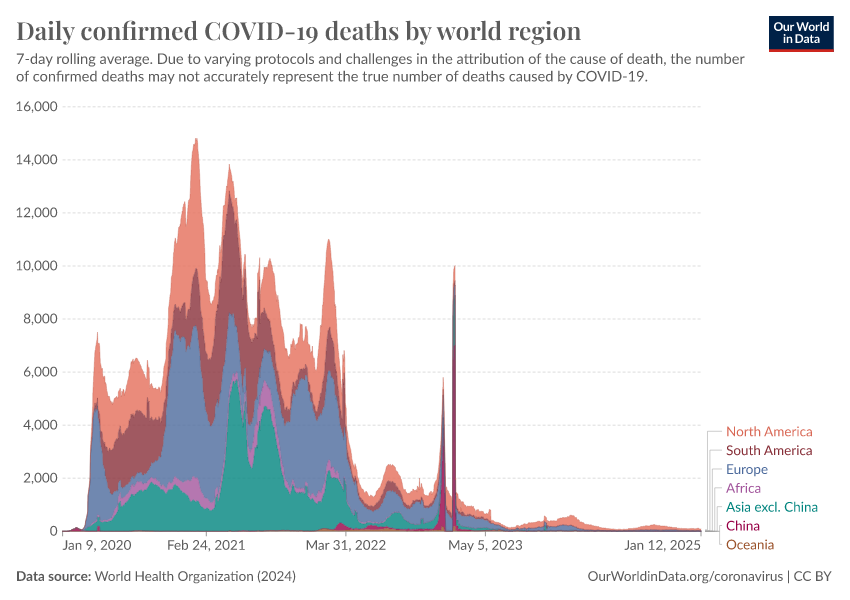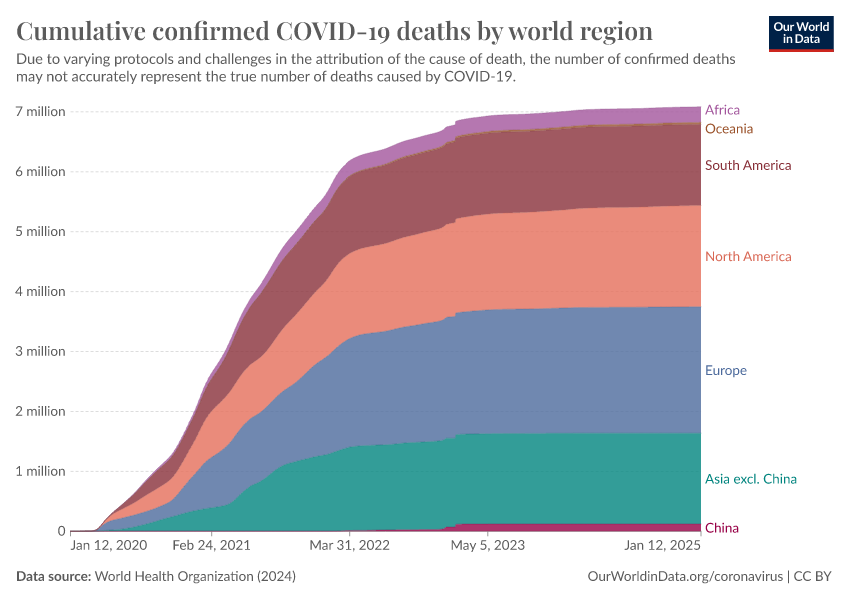Coronavirus Pandemic
We are no longer updating this data
For several years during the pandemic, our team at Our World in Data published daily updates on a range of crucial indicators and developed two global datasets on testing and vaccination.
You can find these and other related indicators here on this country profile and on our main COVID-19 Pandemic topic page.
Reliable data was crucial during the pandemic to track its course and guide public health efforts, research, and policies. It remains crucial for understanding past pandemics and for reducing their risk in the future.
Although our COVID-19 datasets are no longer being updated, we continue to make the data accessible to support this learning.
What is the daily number of confirmed cases in Albania?
This chart shows the number of confirmed COVID-19 cases per day. This is shown as the seven-day rolling average.
What is important to note about these case figures?
- The reported case figures on a given date do not necessarily show the number of new cases on that day – this is due to delays in reporting.
- The number of confirmed cases is lower than the true number of infections – this is due to limited testing. In a separate post we discuss how models of COVID-19 help us estimate the true number of infections.
Daily confirmed cases: how does Albania compare to other countries?
Differences in the population size between different countries are often large. To compare countries, it is insightful to look at the number of confirmed cases per million people – this is what the chart shows.
Keep in mind that in countries that do very little testing the actual number of cases can be much higher than the number of confirmed cases shown here.
What is Albania’s cumulative number of confirmed cases?
The previous charts looked at the number of confirmed cases per day – this chart shows the cumulative number of confirmed cases since the beginning of the COVID-19 pandemic.
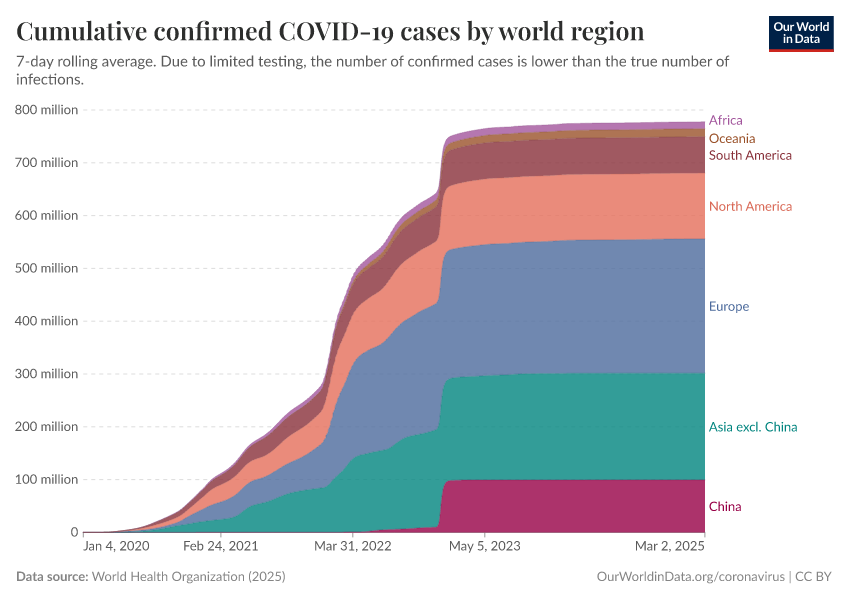
Cumulative confirmed COVID-19 cases by world region
7-day rolling average. Due to limited testing, the number of confirmed cases is lower than the true number of infections.

Total COVID-19 tests conducted vs. confirmed cases
Comparisons across countries are affected by differences in testing policies and reporting methods.
Biweekly cases: where are confirmed cases in Albania increasing or falling?
Why is it useful to look at biweekly changes in confirmed cases?
For all global data sources on the pandemic, daily data does not necessarily refer to the number of new confirmed cases on that day – but to the cases reported on that day.
Since reporting can vary significantly from day to day – irrespectively of any actual variation of cases – it is helpful to look at a longer time span that is less affected by the daily variation in reporting. This provides a clearer picture of where the pandemic is accelerating, staying the same, or reducing.
The first map here provides figures on the number of confirmed cases in the last two weeks. To enable comparisons across countries it is expressed per million people of the population.
And the second map shows the percentage change (growth rate) over this period: blue are all those countries in which the case count in the last two weeks was lower than in the two weeks before. In red countries the case count has increased.
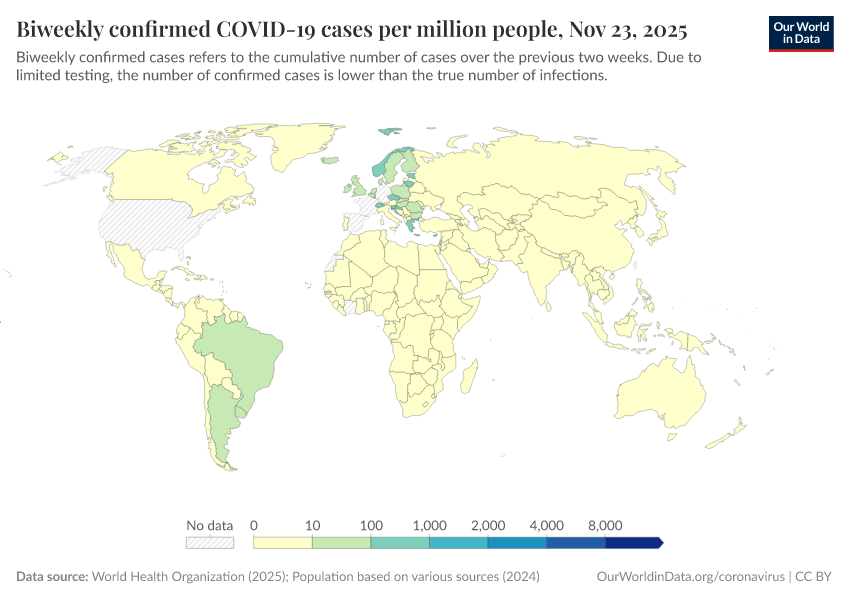
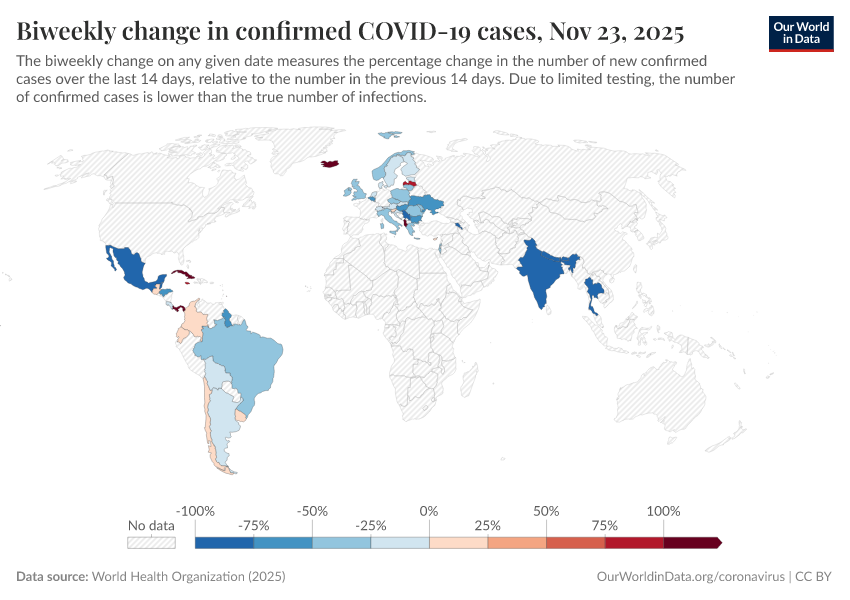
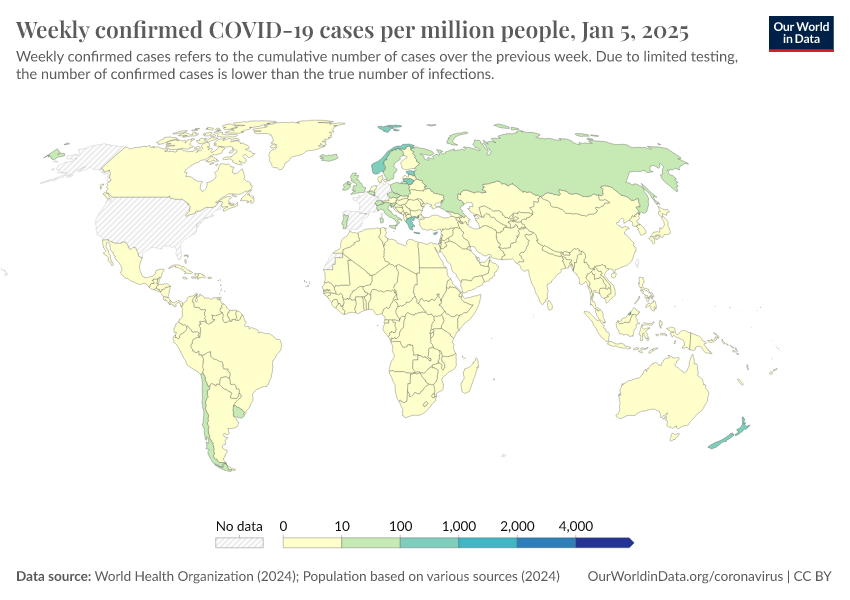
Weekly confirmed COVID-19 cases per million people
Weekly confirmed cases refers to the cumulative number of cases over the previous week. Due to limited testing, the number of confirmed cases is lower than the true number of infections.
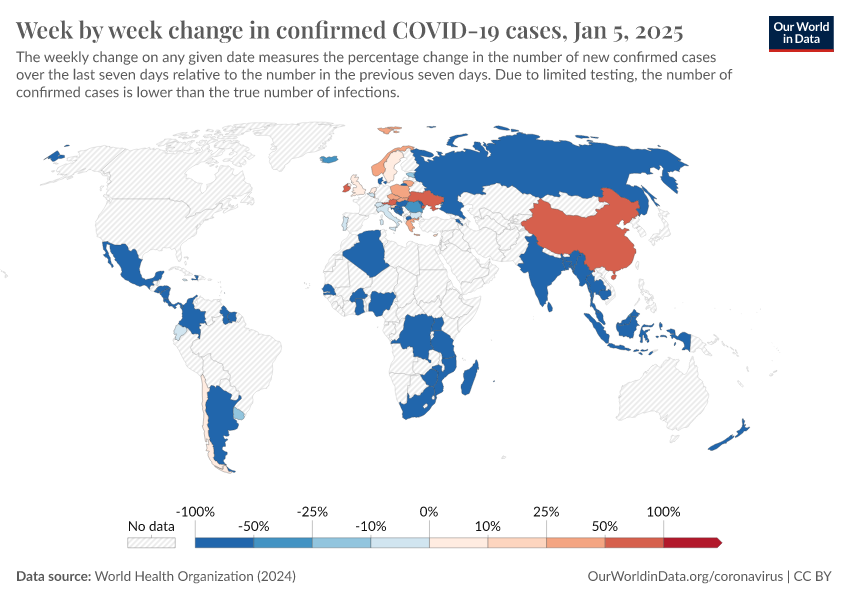
Week by week change in confirmed COVID-19 cases
The weekly change on any given date measures the percentage change in the number of new confirmed cases over the last seven days relative to the number in the previous seven days. Due to limited testing, the number of confirmed cases is lower than the true number of infections.
What is the daily number of confirmed deaths in Albania?
Three points on confirmed death figures to keep in mind
All three points are true for all currently available international data sources on COVID-19 deaths:
- The actual death toll from COVID-19 is likely to be higher than the number of confirmed deaths – this is due to limited testing and challenges in the attribution of the cause of death. The difference between confirmed deaths and actual deaths varies by country.
- How COVID-19 deaths are determined and recorded may differ between countries.
- The death figures on a given date do not necessarily show the number of new deaths on that day, but the deaths reported on that day. Since reporting can vary significantly from day to day – irrespectively of any actual variation of deaths – it is helpful to view the seven-day rolling average of the daily figures as we do in the chart here.
Confirmed deaths: how does Albania compare to other countries?
Why adjust for the size of the population?
This chart shows the daily confirmed deaths per million people of a country’s population.
Differences in the population size between countries are often large, and the COVID-19 death count in more populous countries tends to be higher. Because of this it can be insightful to know how the number of confirmed deaths in a country compares to the number of people who live there, especially when comparing across countries.
For instance, if 1,000 people died in Iceland, out of a population of about 340,000, that would have a far bigger impact than the same number dying in the United States, with its population of 331 million.1 This difference in impact is clear when comparing deaths per million people of each country’s population – in this example it would be roughly 3 deaths/million people in the US compared to a staggering 2,941 deaths/million people in Iceland.
What is Albania’s cumulative number of confirmed deaths?
The previous charts looked at the number of confirmed deaths per day – this chart shows the cumulative number of confirmed deaths since the beginning of the COVID-19 pandemic.
Cumulative confirmed deaths: how does Albania compare to other countries?
This chart shows the cumulative number of confirmed deaths per million people.
Biweekly deaths: are confirmed deaths in Albania increasing or falling?
Why is it useful to look at biweekly changes in deaths?
For all global data sources on the pandemic, daily data does not necessarily refer to deaths on that day – but to the deaths reported on that day.
Since reporting can vary significantly from day to day – irrespectively of any actual variation of deaths – it is helpful to look at a longer time span that is less affected by the daily variation in reporting. This provides a clearer picture of where the pandemic is accelerating, staying the same, or reducing.
The first map here provides figures on the number of confirmed deaths in the last two weeks. To enable comparisons across countries it is expressed per million people of the population.
And the second map shows the percentage change (growth rate) over this period: blue are all those countries in which the death count in the last two weeks was lower than in the two weeks before. In red countries the death count has increased.
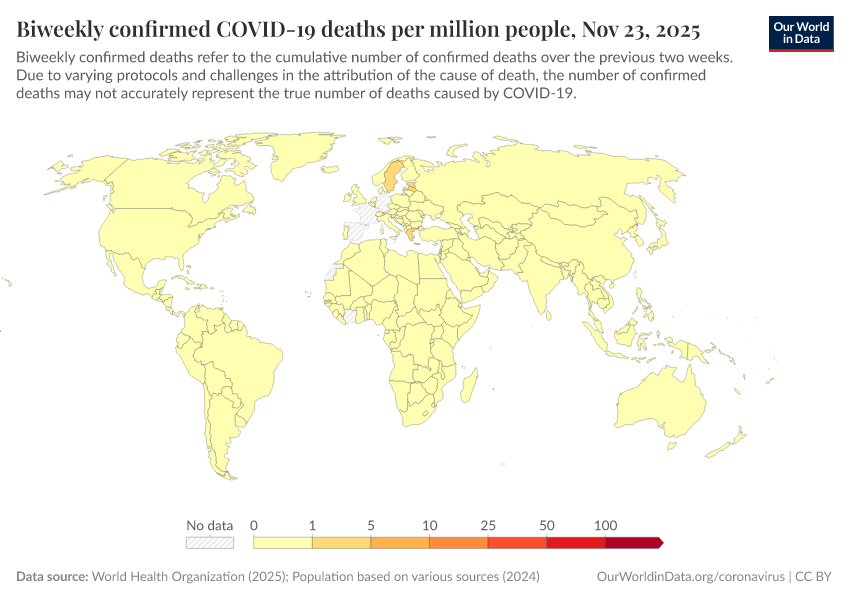
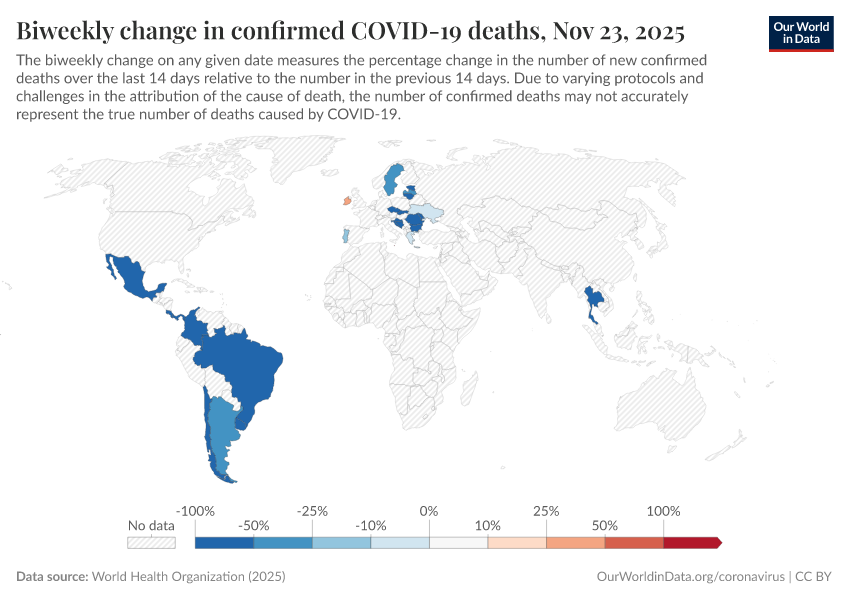
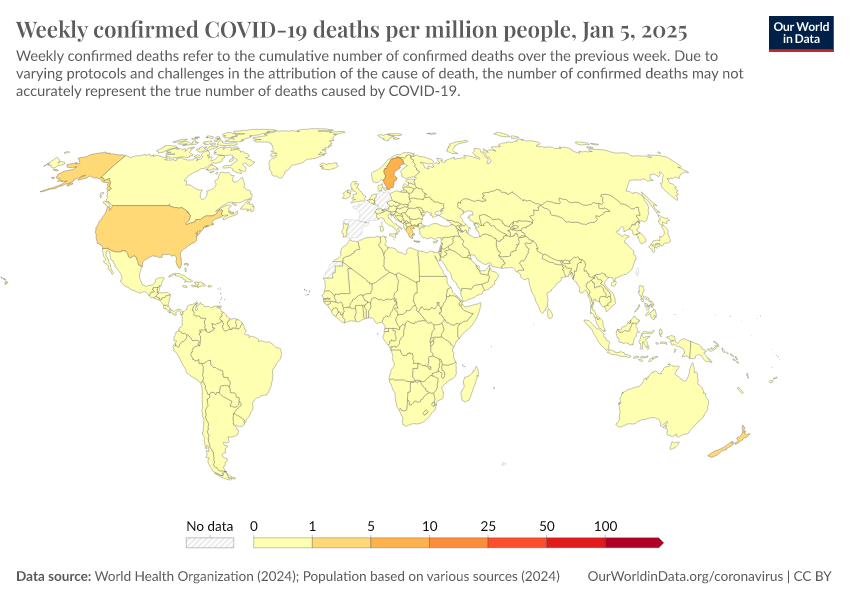
Weekly confirmed COVID-19 deaths per million people
Weekly confirmed deaths refer to the cumulative number of confirmed deaths over the previous week. Due to varying protocols and challenges in the attribution of the cause of death, the number of confirmed deaths may not accurately represent the true number of deaths caused by COVID-19.
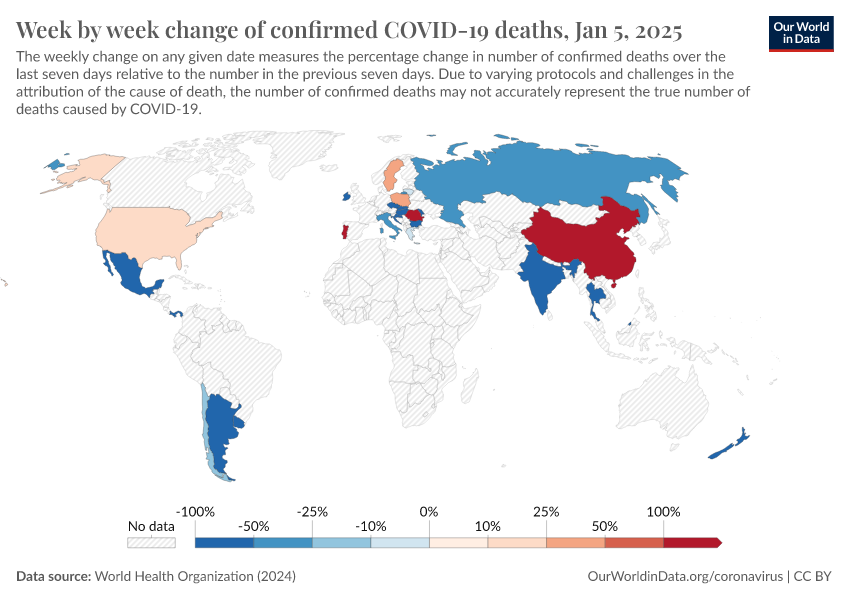
Week by week change of confirmed COVID-19 deaths
The weekly change on any given date measures the percentage change in number of confirmed deaths over the last seven days relative to the number in the previous seven days. Due to varying protocols and challenges in the attribution of the cause of death, the number of confirmed deaths may not accurately represent the true number of deaths caused by COVID-19.
How many COVID-19 vaccine doses are administered in Albania daily?
This chart shows the daily number of COVID-19 vaccine doses administered per 100 people in a given population. This is shown as the rolling seven-day average. Note that this is counted as a single dose, and may not equal the total number of people vaccinated, depending on the specific dose regime (e.g., people receive multiple doses).
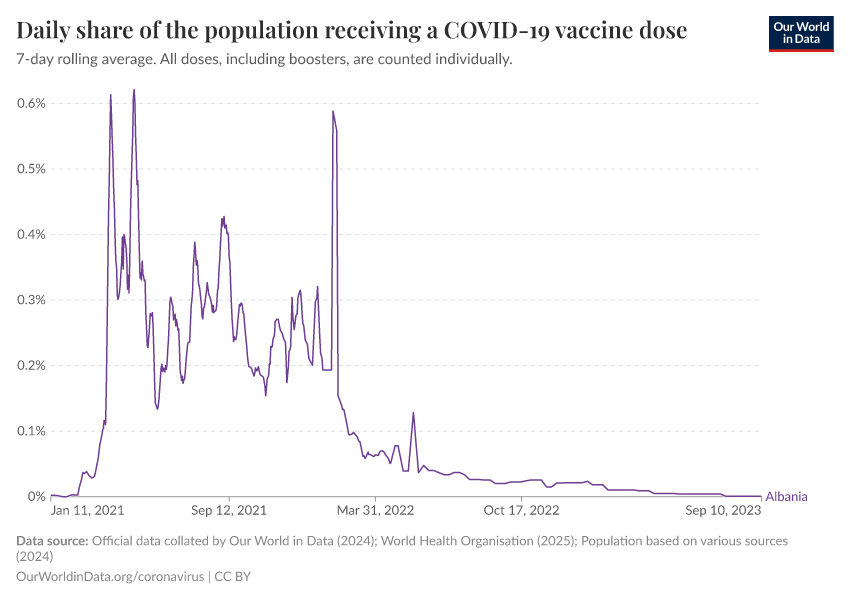
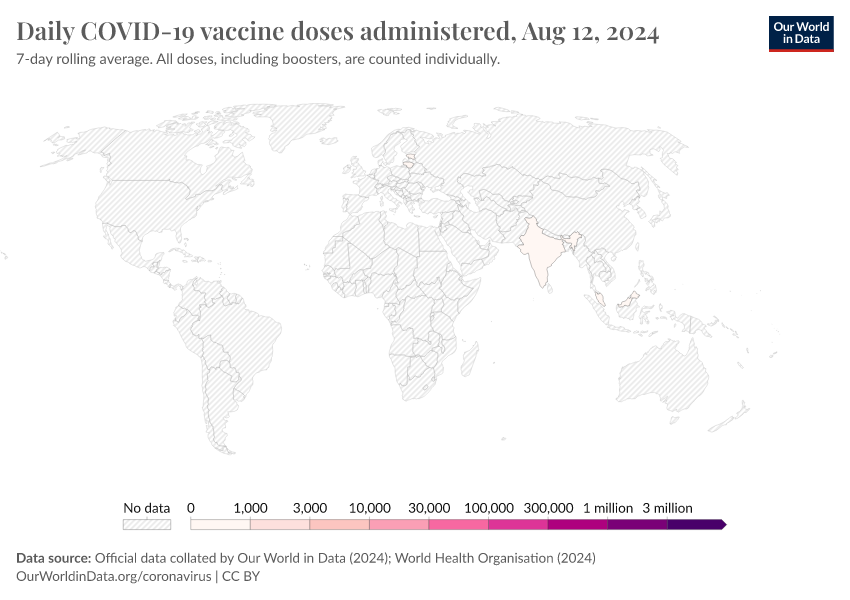
Daily COVID-19 vaccine doses administered
7-day rolling average. All doses, including boosters, are counted individually.
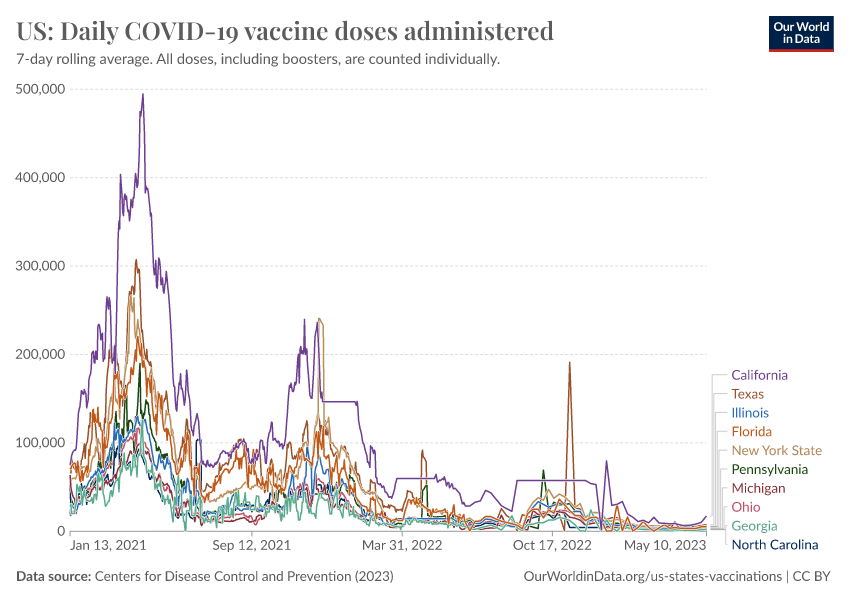
US: Daily COVID-19 vaccine doses administered
7-day rolling average. All doses, including boosters, are counted individually.
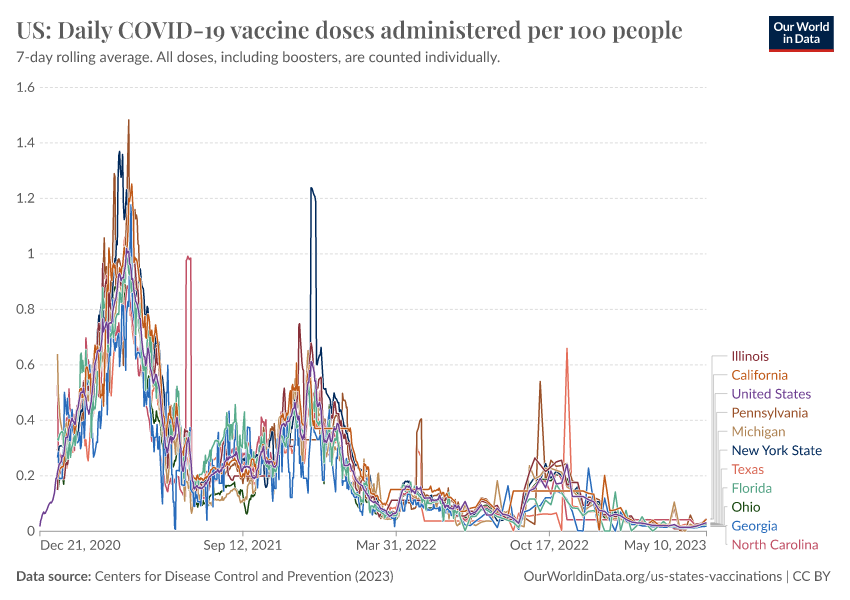
US: Daily COVID-19 vaccine doses administered per 100 people
7-day rolling average. All doses, including boosters, are counted individually.
How many COVID-19 vaccine doses have been administered in Albania in total?
This chart shows the total number of COVID-19 vaccine doses administered per 100 people within a given population. Note that this is counted as a single dose, and may not equal the total number of people vaccinated, depending on the specific dose regime as several available COVID vaccines require multiple doses.

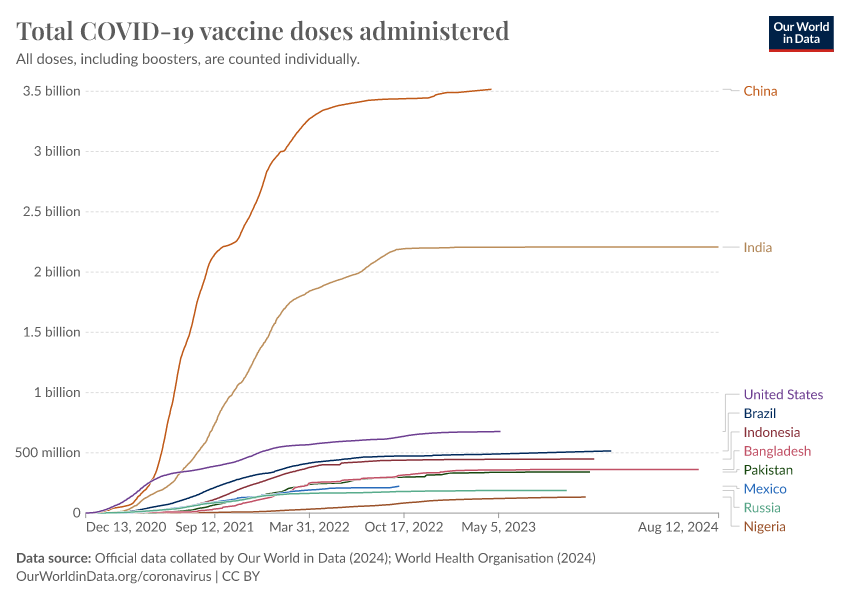
Total COVID-19 vaccine doses administered
All doses, including boosters, are counted individually.
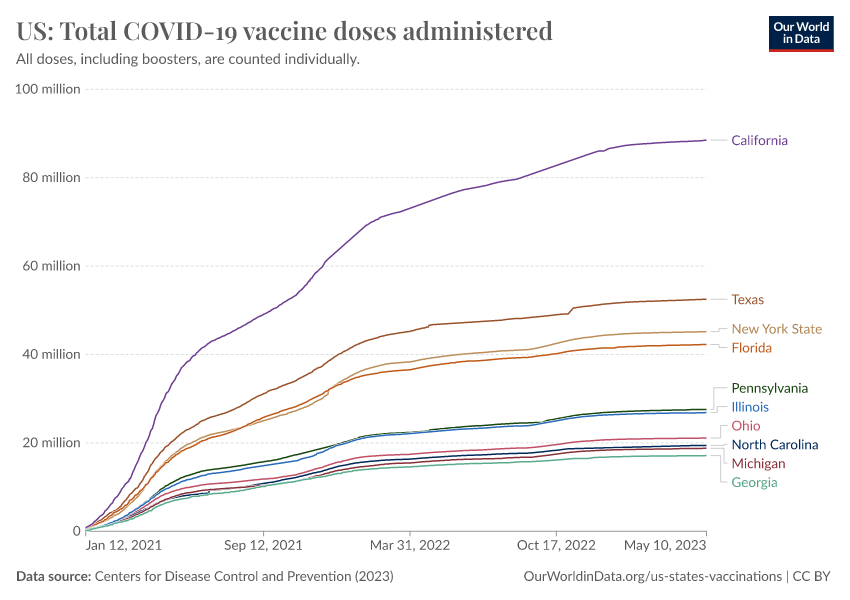
US: Total COVID-19 vaccine doses administered
All doses, including boosters, are counted individually.
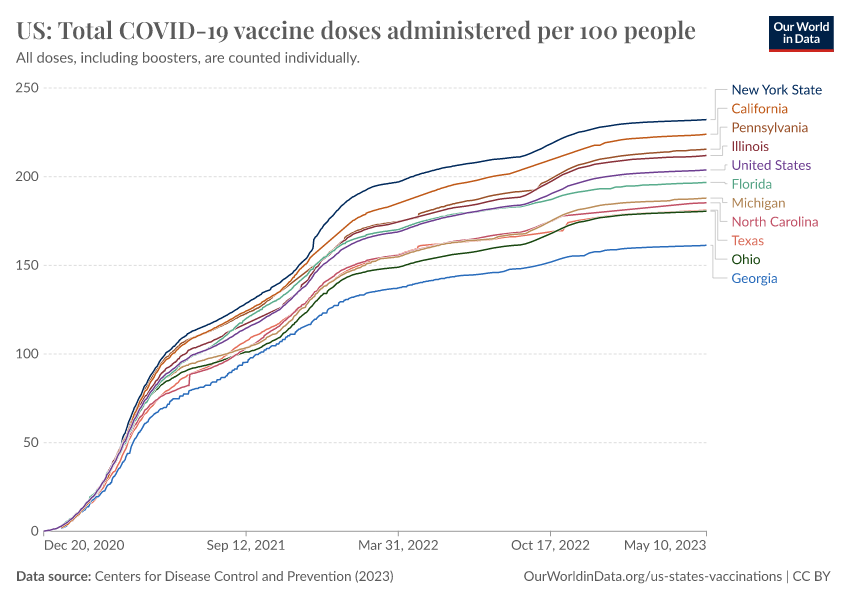
US: Total COVID-19 vaccine doses administered per 100 people
All doses, including boosters, are counted individually.
What share of Albania’s population has received at least one dose of the COVID-19 vaccine?
This chart shows the share of the total population that has received at least one dose of the COVID-19 vaccine. This may not equal the share with a complete initial protocol if the vaccine requires two doses. If a person receives the first dose of a 2-dose vaccine, this metric goes up by 1. If they receive the second dose, the metric stays the same.
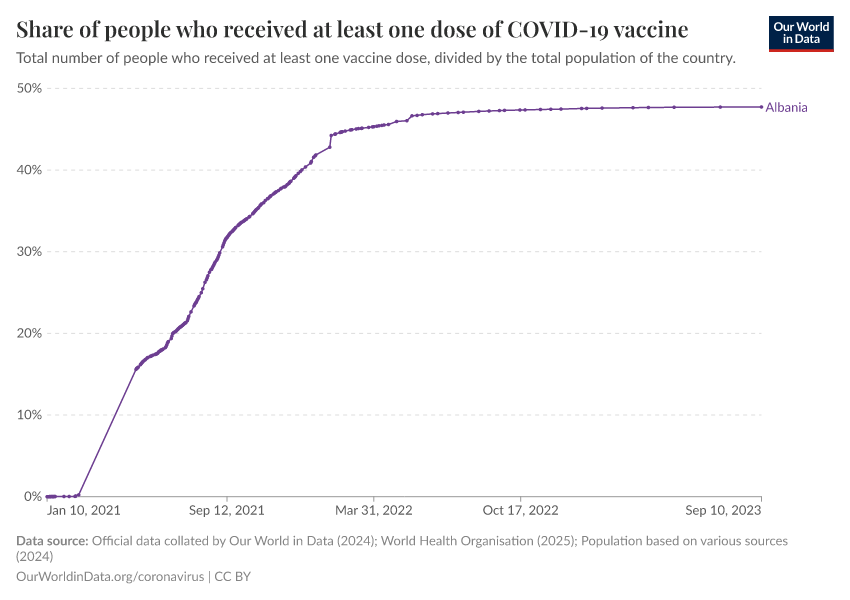
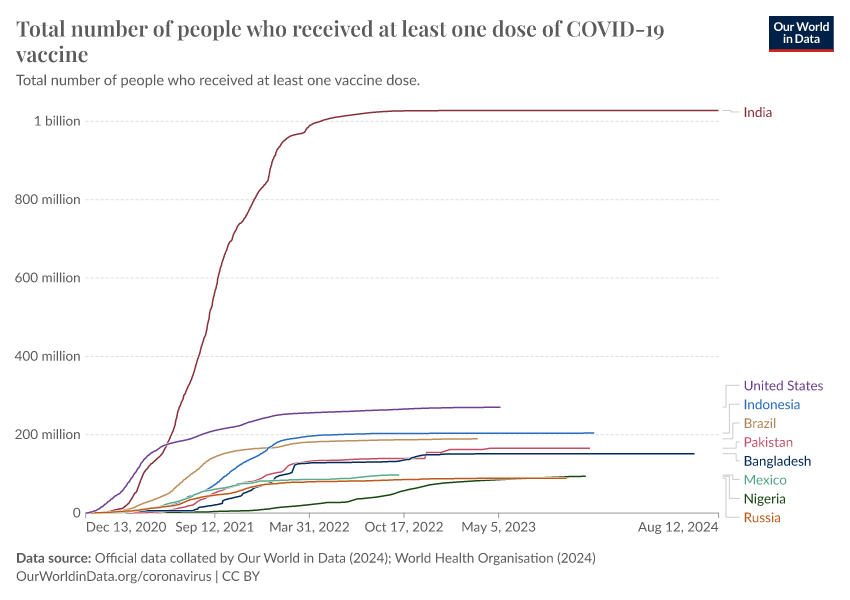
Total number of people who received at least one dose of COVID-19 vaccine
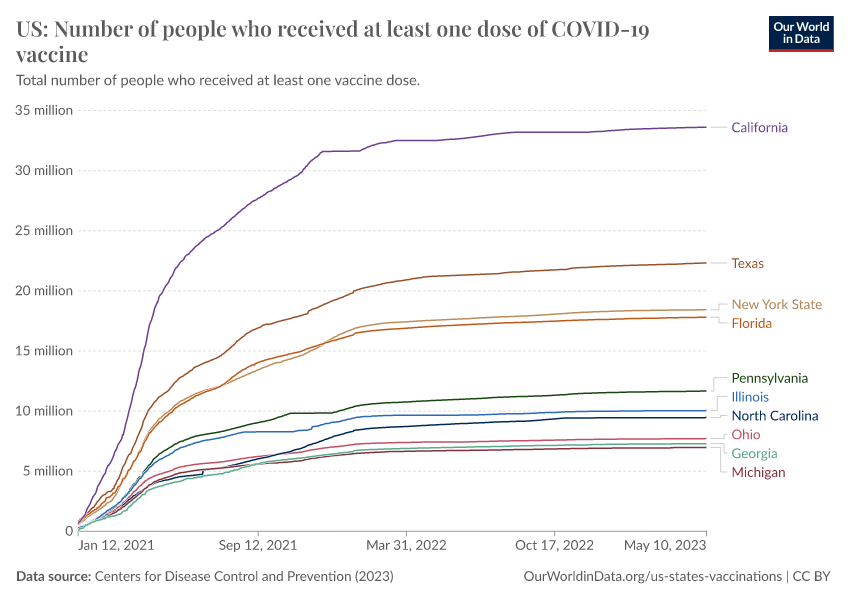
US: Number of people who received at least one dose of COVID-19 vaccine
Total number of people who received at least one vaccine dose.
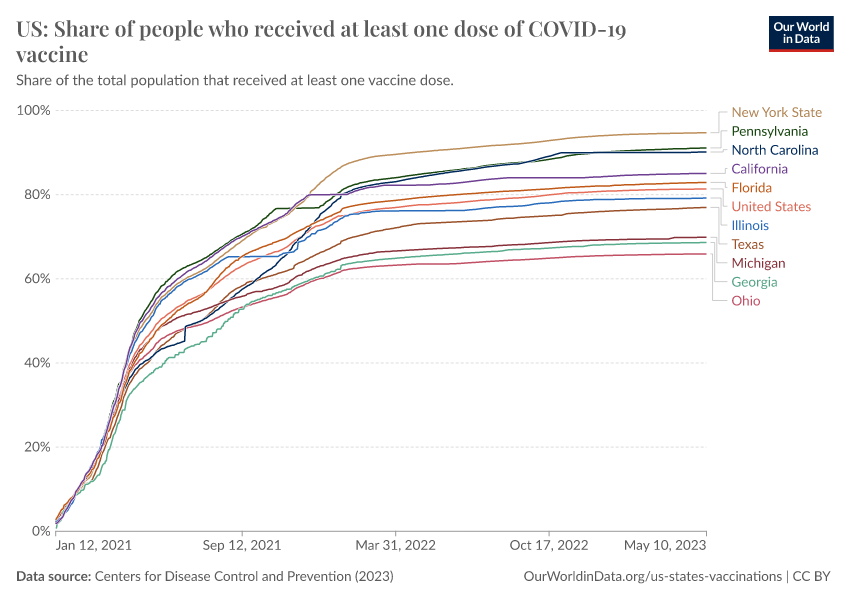
US: Share of people who received at least one dose of COVID-19 vaccine
Share of the total population that received at least one vaccine dose.
What share of Albania’s population has completed the initial vaccination protocol?
The following chart shows the share of the total population that has completed the initial vaccination protocol. If a person receives the first dose of a 2-dose vaccine, this metric stays the same. If they receive the second dose, the metric goes up by 1.
This data is only available for countries which report the breakdown of doses administered by first and second doses.

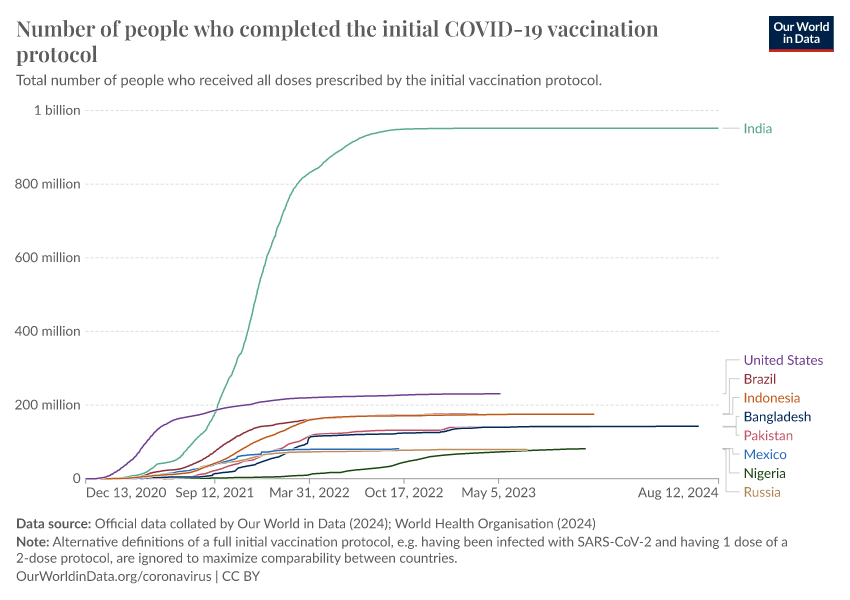
Number of people who completed the initial COVID-19 vaccination protocol
Total number of people who received all doses prescribed by the initial vaccination protocol.
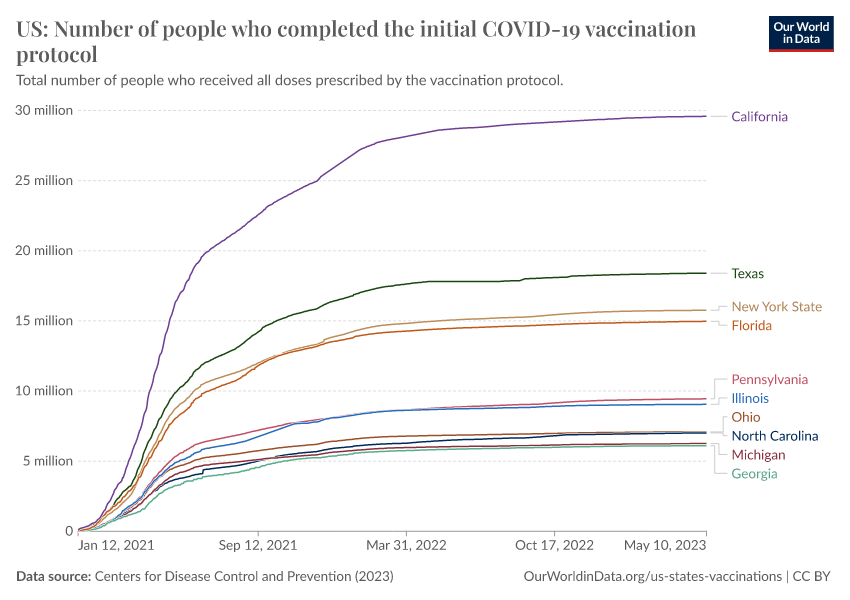
US: Number of people who completed the initial COVID-19 vaccination protocol
Total number of people who received all doses prescribed by the vaccination protocol.
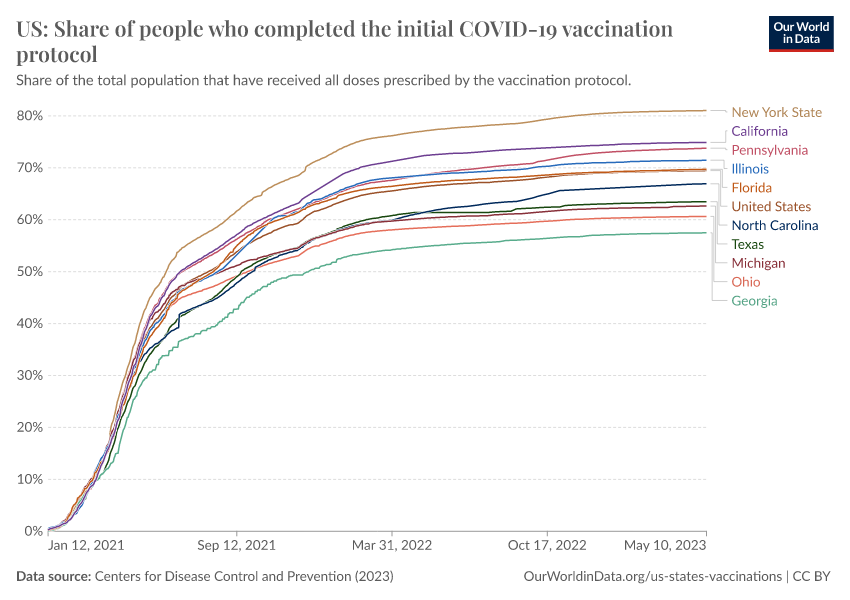
US: Share of people who completed the initial COVID-19 vaccination protocol
Share of the total population that have received all doses prescribed by the vaccination protocol.
Albania’s positive rate
Here we show the share of reported tests returning a positive result – known as the positive rate.
The positive rate can be a good metric for how adequately countries are testing because it can indicate the level of testing relative to the size of the outbreak. To be able to properly monitor and control the spread of the virus, countries with more widespread outbreaks need to do more testing
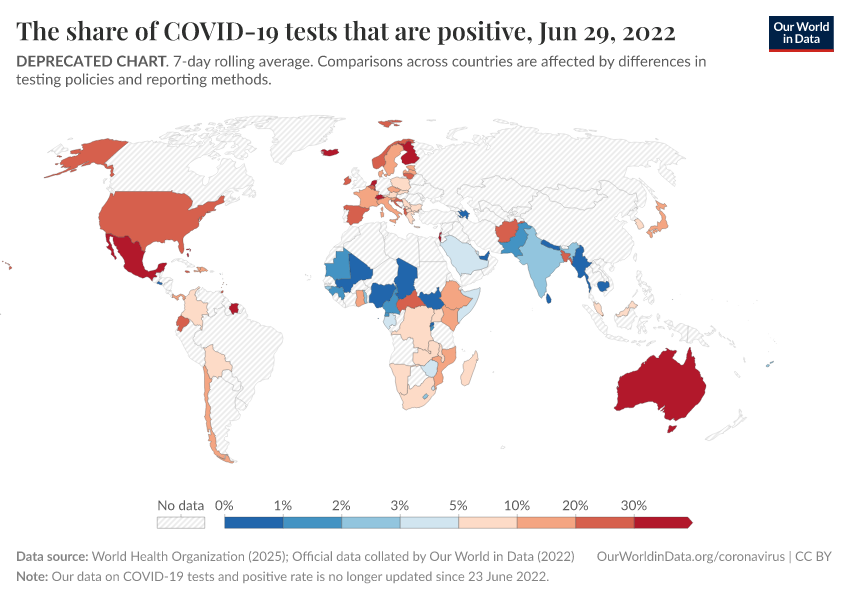
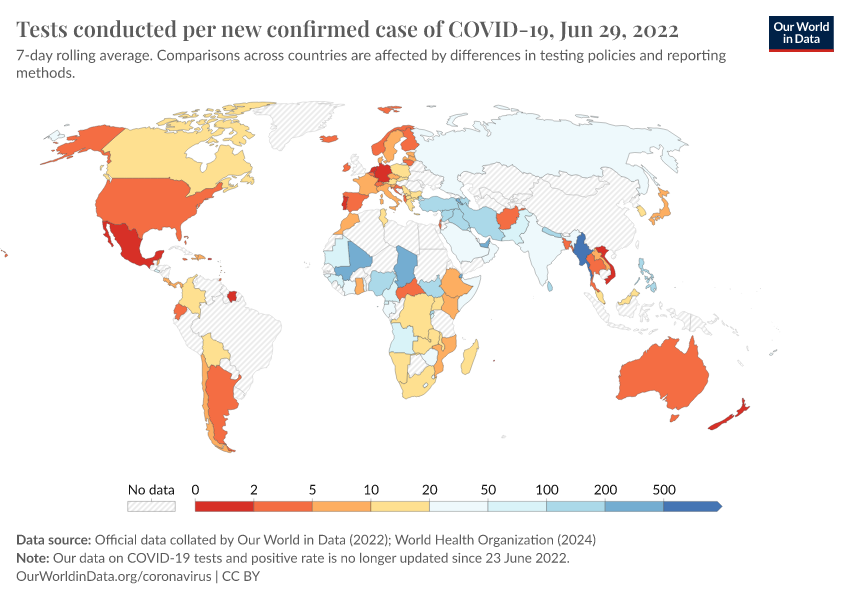
Tests conducted per new confirmed case of COVID-19
7-day rolling average. Comparisons across countries are affected by differences in testing policies and reporting methods.
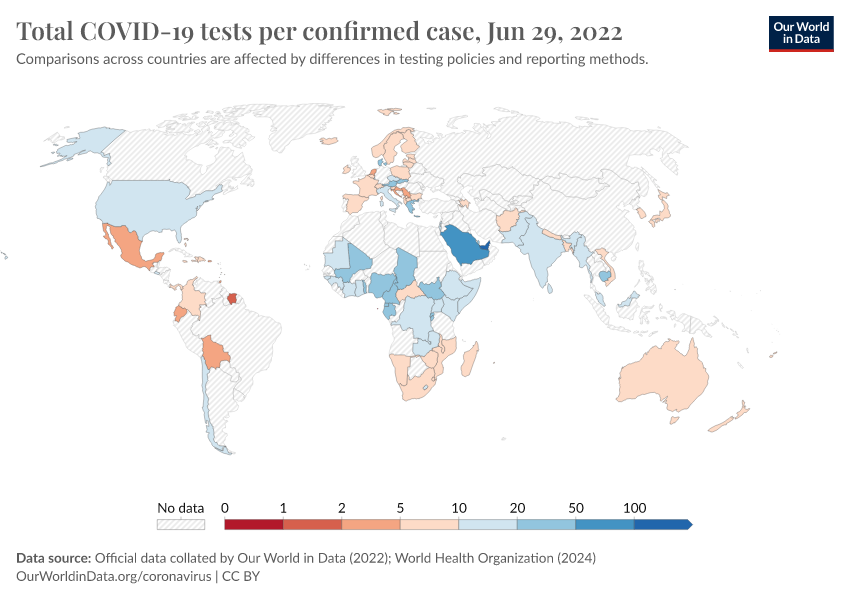
Total COVID-19 tests per confirmed case
Comparisons across countries are affected by differences in testing policies and reporting methods.
The scale of testing compared to the scale of the outbreak
This scatter chart provides another way of seeing the extent of testing relative to the scale of the outbreak in different countries.
The chart shows the daily number of tests (vertical axis) against the daily number of new confirmed cases (horizontal axis), both per million people.
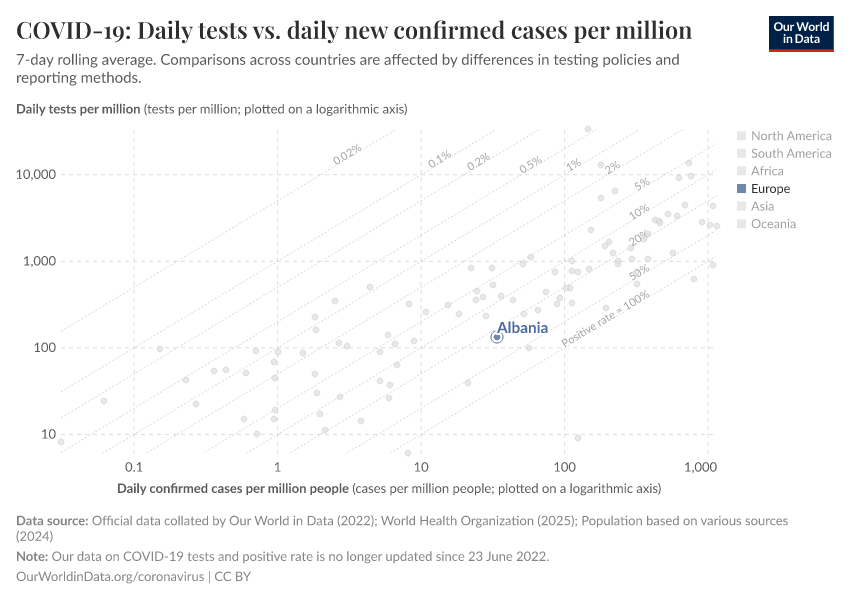
How many tests are performed in Albania each day?
This chart shows the number of daily tests per thousand people. Because the number of tests is often volatile from day to day, we show the figures as a seven-day rolling average.

What is counted as a test?
The number of tests does not refer to the same thing in each country – one difference is that some countries report the number of people tested, while others report the number of tests (which can be higher if the same person is tested more than once). And other countries report their testing data in a way that leaves it unclear what the test count refers to exactly.
We indicate the differences in the chart and explain them in detail in our accompanying source descriptions.
What does the data on deaths and cases tell us about the mortality risk of COVID-19?
To understand the risks and respond appropriately we would also want to know the mortality risk of COVID-19 – the likelihood that someone who is infected with the disease will die from it.
We look into this question in more detail on our page about the mortality risk of COVID-19, where we explain that this requires us to know – or estimate – the number of total cases and the final number of deaths for a given infected population.
Because these are not known, we discuss what the current data on confirmed deaths and cases can and can not tell us about the risk of death. This chart shows both those metrics.
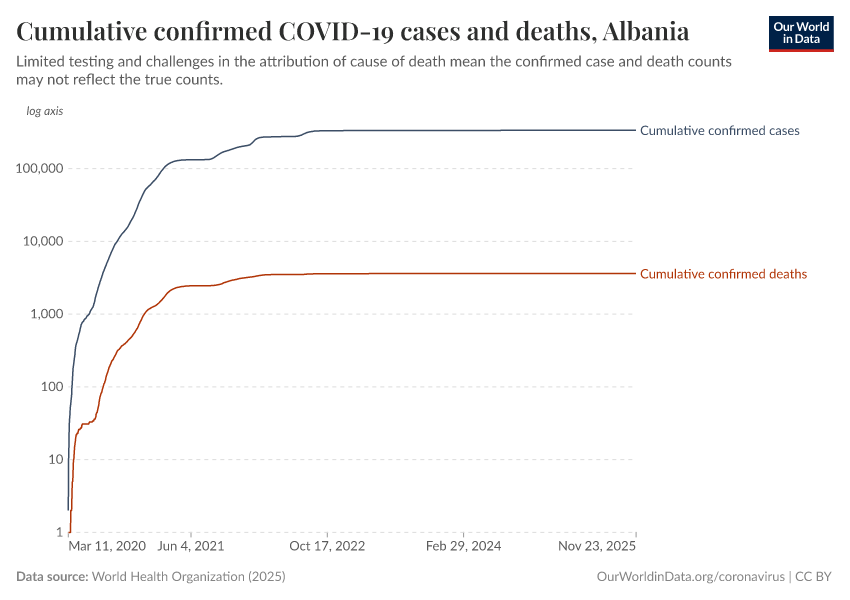
Albania’s case fatality rate
The case fatality rate is simply the ratio of the two metrics shown in the chart above.
The case fatality rate is the number of confirmed deaths divided by the number of confirmed cases.
This chart here plots the CFR calculated in just that way.
During an outbreak – and especially when the total number of cases is not known – one has to be very careful in interpreting the CFR. We wrote a detailed explainer on what can and can not be said based on current CFR figures.
Government responses
To understand how governments have responded to the pandemic, we rely on data from the Oxford Coronavirus Government Response Tracker (OxCGRT), which is published and managed by researchers at the Blavatnik School of Government at the University of Oxford.
This tracker collects publicly available information on 17 indicators of government responses, spanning containment and closure policies (such as school closures and restrictions in movement); economic policies; and health system policies (such as testing regimes).
Albania’s Government Stringency Index
The chart here shows how governmental response has changed over time. It shows the Government Stringency Index – a composite measure of the strictness of policy responses.
The index on any given day is calculated as the mean score of nine policy measures, each taking a value between 0 and 100. See the authors’ full description of how this index is calculated.
A higher score indicates a stricter government response (i.e. 100 = strictest response).
The OxCGRT project calculates this index using nine specific measures, including:
- school and workplace closures;
- restrictions on public gatherings;
- transport restrictions;
- and stay-at-home requirements.
You can see all of these separately on our page on policy responses. There you can also compare these responses in countries across the world.
Endnotes
Here is our visualization for the population of Iceland and the US. Any other country can be added to this chart.
Cite this work
Our articles and data visualizations rely on work from many different people and organizations. When citing this profile page, please also cite the underlying data sources. This profile page can be cited as:
Hannah Ritchie (2025) - “Coronavirus Pandemic” Published online at OurWorldinData.org. Retrieved from: 'https://ourworldindata.org/profile/coronavirus/albania' [Online Resource]BibTeX citation
@article{owid-profile-coronavirus-albania,
author = {Hannah Ritchie},
title = {Coronavirus Pandemic},
journal = {Our World in Data},
year = {2025},
note = {https://ourworldindata.org/profile/coronavirus/albania}
}Reuse this work freely
All visualizations, data, and code produced by Our World in Data are completely open access under the Creative Commons BY license. You have the permission to use, distribute, and reproduce these in any medium, provided the source and authors are credited.
The data produced by third parties and made available by Our World in Data is subject to the license terms from the original third-party authors. We will always indicate the original source of the data in our documentation, so you should always check the license of any such third-party data before use and redistribution.
All of our charts can be embedded in any site.
